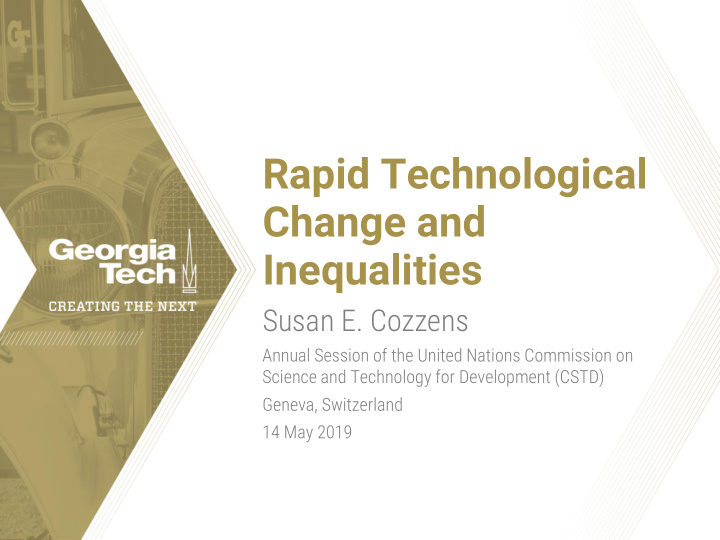



Rapid Technological Change and Inequalities Susan E. Cozzens Annual Session of the United Nations Commission on Science and Technology for Development (CSTD) Geneva, Switzerland 14 May 2019
Inequalities • Vertical dimension – rich/poor • Global inequality at household level • Country makes a huge difference. • Household livelihood and consumer roles, too. • Horizontal dimension – culturally defined groups • Gender • Religion • Others • Dynamics • Between countries • Within countries • Across the world system
Global system • Colonial • Extraction of raw resources • Industrial • Machine manufacturing • Exchange raw materials for manufactured goods • Informational (globalization) • Information and transportation technologies • Reciprocal exchange of manufactured goods • Fourth Industrial Revolution (4IR) • Data is the raw material, gathered globally. • Data analysis, machine learning are key production processes.
Classic innovation theory • Firms innovate to stay in business and make money. • Process innovations – competitive advantage • Tend to be employment-reducing • Product innovations – monopoly “rents” • Tend to be employment-increasing • In the Fourth Industrial Revolution • Business opportunities come from combinations of data and analysis. • Analytic skills are at a premium. • Jobs generated are often in service. • Geographic range is global.
Households in the global system • “Core” • Some households become extremely wealthy. • Partly through hyper-wages • Partly through accumulation of capital • “Periphery” • Other households are left completely out of the system. • “Black holes of the information economy” • Huge worldwide informal sector • “Semi - periphery” • Firms and countries seeking their roles in an economy with a new shape. • Great inequalities within countries come from different household roles in the global system.
Where do inequality-reducing innovations come from in this system? • Sometimes the market • Example: mobile phones • Sometimes social entrepreneurship • Example: Aravind Eye Institutes • Sometimes public funding • Example: Nerica rice • Sometimes public procurement • Example: Aadhaar identity system
Roles for national policymakers Lessons learned from case studies • A little expertise goes a long way. • Use many kinds of policies • Anti-trust • Safety regulation • Keep distributional consequences in view. • Think about both primary and secondary employment effects (sales, service, etc.) • Keep IP accessible Source: Innovation and Inequalities: Emerging Technologies in an Unequal World, Cozzens and Thakur, Edward Elgar Publishers
• Even the playing field. • Articulate public standards. • Health • Food • Workplace safety • Share and analyze success factors. • Keep the spotlight on the horizontal inequalities. • In the end, it is Roles for about everyone being “agents, not patients.” international institutions
Recommend
More recommend